The first time “Olivia” fled from her foster care placement, she was just 14 years old.
“I had very adverse childhood experiences before I went into care,” said Olivia, who went into care at age 14 in the early 2000s.
“I was already very vulnerable and fleeing before I even went into care.”
Olivia is not her real name — The Tyee is using a pseudonym to protect her privacy.
These experiences included abuse, family conflict and a lack of support to address her complex trauma.
Olivia spent her four and a half years in care in a foster home in Port Coquitlam. She says it felt more like a group home to her because it only housed teenage girls.
The foster parent did not receive ongoing training to address the complex needs of girls in the house. This led to many of them struggling with mental health and misusing substances. There was a lack of support and resources, Olivia says.
“I was not the only one running in that home. There were other girls disappearing at the time, too,” she said.
Two decades later, young people in the child welfare system are still fleeing placements and the Representative for Children and Youth’s office says the Ministry for Children and Family Development doesn’t always know where they are.
That’s the subject of Missing: Why are children disappearing from B.C.’s child welfare system?, the latest report from the representative’s office, which identifies 198 young people in care reported missing to the representative’s office between April and December 2022.
All 198 young people have since been located, including four youth, three of whom were First Nations, who died during this time period.
The representative’s report also includes information from the Children and Family Development Ministry, including 152 kids and youth reported to the ministry as missing from April to December 2022, and past reports like a 2019 analysis of young people who had left their care placements at least once over a three-year period.
Of the young people identified as missing in the report, the majority were teenagers, Indigenous — including an overrepresentation of Indigenous girls — and lived in group homes. Many had mental health and substance use issues, as well as disabilities.
The report also notes 198 kids is likely an undercount.
“This isn’t perfect,” said Jennifer Dreyer, executive director of Systemic Advocacy, First Nations, Métis and Inuit Research within the representative’s office, who led this report. “It’s what we have now.”
Work on the report started in October 2022, but it was released earlier than planned because of the alarming number of young people who had fled their care placements.
“But we need to start a conversation with haste, to prevent children from being lost or missing and disappearing in care,” Dreyer said.
In one prominent case The Tyee reported last year, 14 year-old Noelle “Ellie” O’Soup was found deceased in a single-room occupancy hotel in Vancouver’s Downtown Eastside.
O’Soup, who was Métis with connections to Tk’emlúps te Secwépemc in B.C. and Key First Nation in Saskatchewan, had been missing from their Port Coquitlam foster home for nearly a year.
In September 2020, the body of Traevon Desjarlais-Chalifoux, who was Cree and 17 years-old, was found deceased in his closet four days after he was reported missing from his Abbotsford group home.
‘Nobody ever came looking for me’
Although Olivia was from the Lower Mainland, she had no family or community connections in Port Coquitlam. Staying just 15 minutes from the Pickton farm during Robert Pickton’s multiple murder trial, Port Coquitlam felt very dangerous for girls and young women at the time.
Olivia describes the teenager she was at the time as having “disorganized attachment” — not always recognizing when she was unsafe. One of the main causes, she says, was entering a relationship with someone involved with crime.
Sometimes Olivia found herself at the homes of adults she didn’t know, surrounded by people under the influence of what she describes as heavy drugs. Strangers, often much older men, would strike up conversations and invite her places.
“You end up in these super questionable situations and your boundaries of safety get super weird: you can no longer recognize what’s safe and what’s not,” said Olivia, who became a youth worker in adulthood.
Initially when Olivia fled her foster home, which happened a couple of times a month, she would just be gone for a night or two. But eventually Olivia’s sojourns lasted up to two weeks.
The furthest she travelled was over 100 kilometres away to Hope.
Now an adult, Olivia recognizes she is lucky to be alive. Not every young person fleeing their child welfare placement has been found safe.
“Nobody ever came looking for me, because they couldn’t find me,” Olivia said, adding she believes her foster parent didn’t always contact the authorities because they assumed she would be back.
‘There’s this trifecta of complexity’
Neither Dreyer nor Representative for Children and Youth Jennifer Charlesworth blame young people for fleeing care placements.
“Young people are voting with their feet,” Charlesworth said, “because they’re not getting their needs met.”
Nor do they place the blame on the adults who work with them, adding child welfare workers care a lot about the young people they work with.
Instead they lay the blame on the colonial and racist provincial child welfare, health and mental health and addictions systems that aren’t adequately supporting kids in care.
These systems replicate the harms of the residential school system and the ongoing crisis of missing and murdered Indigenous girls, women and Two-Spirit people, they said.
The report references an internal MCFD document examining 19 young people who fled their child welfare placements in October 2022 alone. Nearly 80 per cent use substances and had been evaluated for mental-health concerns, while 63 per cent had a suspected or diagnosed disability.
This is not uncommon for young people in the child welfare system, said Dreyer, and unfortunately most services for young people in these situations are not equipped to help people with complex, overlapping issues.
“There’s this trifecta of complexity, and unfortunately the ways our systems are set up, it’s kind of one or the other: you can’t have all of the above and still access services,” she said, adding kids in care have to sit on the same waitlists as other kids in B.C.
Olivia isn’t sure anyone could have stopped her from fleeing. But she does think she would have benefitted from receiving relevant mental-health services, and support to follow her passions, like playing the guitar and singing.
"What would have been helpful was art therapy, music lessons and a specialized child therapist who understood complex trauma. I had an enormous amount of childhood trauma but every professional around me was constantly worried about my school attendance,” Olivia said, adding she often skipped class to play in bands.
"I was a creative teenager. Skipping school to play music wasn't great, but it kept me alive. If I had been my own youth worker, I would have honed in on that."
Unimplemented recommendations
Earlier in April the representative’s office put out another report that found only 14 per cent of the recommendations from its office since 2018 have been completed.
However both Charlesworth and Dreyer said the recommendations in this report are short and easy to implement.
“We’re asking for small changes that will be some stopgap measures while we do the bigger work of bringing the parties together,” Charlesworth said, adding her office has already been in contact with Minister Mitzi Dean and the provincial director for child welfare about their recommendations.
Some recommendations, like removing the requirement that young people be missing for seven days before their absence is logged with the ministry, have already been adopted.
Other recommendations include engaging with youth immediately about why they flee and what happened to them before and after they left; using child-centred language that does not blame them for their disappearance; and implementing outstanding recommendations like ensuring young people retain connections with their community and culture while in care.
The Tyee contacted MCFD, the health and mental health and addictions ministries for their response to the RCY report. As the report’s recommendations are directed at MCFD, Minister Mitzi Dean responded with an emailed statement on their behalf.
“Nothing is more important than the safety and well-being of the children and youth who are in our care,” Dean wrote. “When a child or youth in care is missing, we want them to receive the same response that a caring parent would give.”
Dean added she is “grateful” to the representative’s office for highlighting changes her ministry can make to strengthen the safety of young people in care, and she committed to working with the Representative and the Indigenous Child and Family Service Agency Directors on addressing the report’s recommendations by Nov. 1, 2023.
“We’ve already made important progress transforming the child welfare system in B.C., but I know we still have a long way to go, and we are committed to taking the steps that are needed to support youth in care,” Dean wrote.
Olivia agrees with the recommendations, and says she wasn't able to communicate that her needs weren’t being met when she was in care because, “I don’t think I had the language for it.”
“Often these children are labelled as problem children, as frustrating, as refusing services. But often this is rooted in multiple experiences of complex trauma, and then that takes a long time to unpack and heal,” Olivia said. “And that isn’t necessarily going to get accomplished while the kid is in care. This is a lifetime journey.”
For those young people who flee or want to flee, Dreyer and Charlesworth want them to know it’s not their fault.
“Find those supportive adults and tell them what it is you need,” Charlesworth said, which includes contacting her office.
“There are a lot of people who care deeply about you, even if you don’t feel it.” ![]()
Read more: Indigenous, Rights + Justice

















Tyee Commenting Guidelines
Comments that violate guidelines risk being deleted, and violations may result in a temporary or permanent user ban. Maintain the spirit of good conversation to stay in the discussion and be patient with moderators. Comments are reviewed regularly but not in real time.
Do:
Do not: